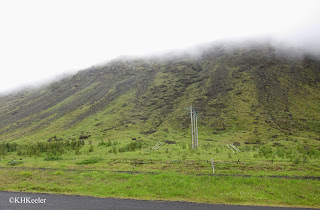 |
| Fields of west central Iceland |
Iceland is an island of 40,000 square miles (the size of the state of Kentucky) in the North Atlantic just barely south of the Arctic Circle. There were no humans until 860 AD when a ship from the Faroes stumbled on it. A few years later a ship captained by Raven Floki came to explore. He found it cold and dangerous and named it Iceland. Settlers arrived in 870. They spread across the land, trying to raise crops on an island with shallow soils and a short growing season. Eventually they gave up growing grains and simply raised livestock on the green fields.
 |
| trees in Reykjavik, Iceland |
 |
| Clouds moving in, western Iceland. |
The weather was exceedingly changeable, with the clouds closing in to rain or opening to let the sun shine within a few minutes of each other. Just because the sun was up didn't mean it was bright and sunny. Conversely we learned that, even if it was cloudless, never to go anywhere without umbrellas.
 |
| Wildflowers, west central Iceland |
 |
| Clover flowers and dandelion leaves, Iceland. |
As elsewhere in high summer, wildflowers were abundant. Many of the wildflowers were familiar because the same ones are found from northern Eurasia to North America. (Have a "circumboreal distribution"). I find don't have great flower pictures because I was taking so many of the landscape. See more flowers here.
And of course many a European weed has hopped to Iceland and as well as occupied large sections of North America.
 |
| More flowers |
More summer flowers below the sign.
 |
| weedy lupin, Iceland |
 |
| Shallow soil on volcanic debris, Iceland |
One of those volcanoes is Mount Heckla, whose awe-inspiring eruption in the Middle Ages so impressed the priests that it was taken literally as the "Gates of Hell." Heckla last erupted in 2000.
Volcanic activity also means there are steam vents and geysers, including Geysir, the geyser that gave us the English world geyser.
My pictures don't take you up into the mountains or onto the glaciers. Much of Iceland isn't very good for homesteading but is great for hiking.
 |
| Rift due to Mid Atlantic Ridge, Iceland |
Life on Iceland has always been punctuated with earthquakes, volcanic eruptions and unpredictable North Atlantic weather. The people farmed in scattered homesteads and came together to solve shared problems each summer in what became Europe's earliest Parliament. They camped at a centrally located site and held an all-Iceland market while the leaders wrestled with island government. The picture below is area where they held the Parliament, the Althing. These days, except for special occasions, the Icelandic parliament meets in comfortable rooms in Reykjavik. (Remember that I said it was likely to rain on you for a few minutes any summer day?)
 |
| Althing site, Thingvellir National Park, Iceland |
There's lots more neat stuff of course--about how the settlers struggled, about their horses, sheep and dogs, the Icelandic Sagas telling their history, the adventures of living on a volcanic island close to the Arctic Circle, of modern Icelandic customs, arts and trendiness. I'll just close with a picture of a field of oilseed rape (Brassica napus) in bloom. I don't want to leave the impression that there is no agriculture. Of course there is, and, with lots of geothermal energy, greenhouses are cheaper to heat than in most places. Anyway, flowering fields are oilseed rape are always gorgeous.
 |
| Field of oilseed rape, Brassica napus, in flower, Iceland |
Comments and corrections welcome.
Join me on Facebook: Facebook.com/awanderingbotanist
Kathy Keeler
website: awanderingbotanist.com
References consulted
Iceland. Is. The official gateway to Iceland. http://www.iceland.is/the-big-picture/nature-environment/volcanoes/
Magnusson, B. 2010. NOBANIS – Invasive Alien Species Fact Sheet
Lupinus nootkatensis http://www.nobanis.org/files/factsheets/Lupinus_nootkatensis.pdf
Related posts: Westmann Islands
No comments:
Post a Comment